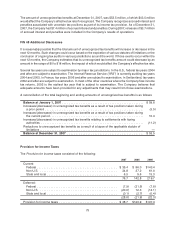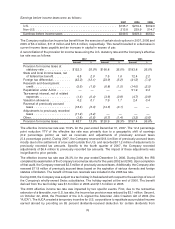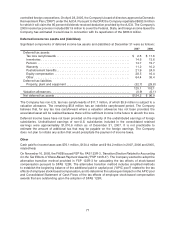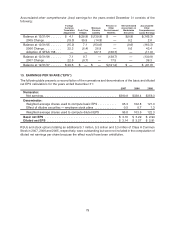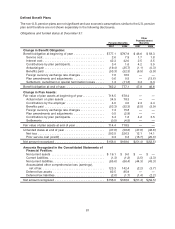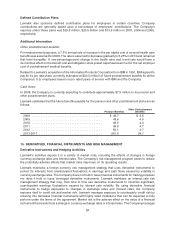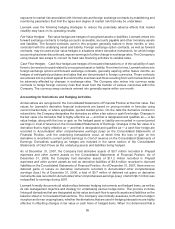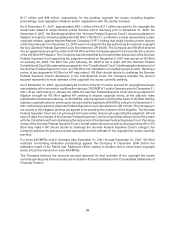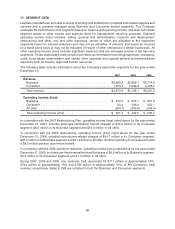Lexmark 2007 Annual Report Download - page 91
Download and view the complete annual report
Please find page 91 of the 2007 Lexmark annual report below. You can navigate through the pages in the report by either clicking on the pages listed below, or by using the keyword search tool below to find specific information within the annual report.exposure to market risk associated with interest rate and foreign exchange contracts by establishing and
monitoring parameters that limit the types and degree of market risk that may be undertaken.
Lexmark uses the following hedging strategies to reduce the potentially adverse effects that market
volatility may have on its operating results:
Fair Value Hedges: Fair value hedges are hedges of recognized assets or liabilities. Lexmark enters into
forward exchange contracts to hedge accounts receivable, accounts payable and other monetary assets
and liabilities. The forward contracts used in this program generally mature in three months or less,
consistent with the underlying asset and liability. Foreign exchange option contracts, as well as forward
contracts, may be used as fair value hedges in situations where derivative instruments, for which hedge
accounting has been discontinued, expose earnings to further change in exchange rates. The Company is
using interest rate swaps to convert its fixed rate financing activities to variable rates.
Cash Flow Hedges: Cash flow hedges are hedges of forecasted transactions or of the variability of cash
flows to be received or paid related to a recognized asset or liability. From time to time, Lexmark enters into
foreign exchange options and forward exchange contracts, generally expiring within twelve months, as
hedges of anticipated purchases and sales that are denominated in foreign currencies. These contracts
are entered into to protect against the risk that the eventual cash flows resulting from such transactions will
be adversely affected by changes in exchange rates. The Company also enters into currency swap
contracts to hedge foreign currency risks that result from the transfer of various currencies within the
Company. The currency swap contracts entered into generally expire within one month.
Accounting for Derivatives and Hedging Activities
All derivatives are recognized in the Consolidated Statements of Financial Position at their fair value. Fair
values for Lexmark’s derivative financial instruments are based on pricing models or formulas using
current market data, or where applicable, quoted market prices. On the date the derivative contract is
entered into, the Company designates the derivative as either a fair value or cash flow hedge. Changes in
the fair value of a derivative that is highly effective as — and that is designated and qualifies as — a fair
value hedge, along with the loss or gain on the hedged asset or liability are recorded in current period
earnings in Cost of revenue on the Consolidated Statements of Earnings. Changes in the fair value of a
derivative that is highly effective as — and that is designated and qualifies as — a cash flow hedge are
recorded in Accumulated other comprehensive earnings (loss) on the Consolidated Statements of
Financial Position, until the underlying transactions occur, at which time the loss or gain on the
derivative is recorded in current period earnings in Cost of revenue on the Consolidated Statements of
Earnings. Derivatives qualifying as hedges are included in the same section of the Consolidated
Statements of Cash Flows as the underlying assets and liabilities being hedged.
As of December 31, 2007, the Company had derivative assets of $0.7 million recorded in Prepaid
expenses and other current assets on the Consolidated Statements of Financial Position. As of
December 31, 2006, the Company had derivative assets of $11.2 million recorded in Prepaid
expenses and other current assets as well as derivative liabilities of $9.8 million recorded in Accrued
liabilities on the Consolidated Statements of Financial Position. As of December 31, 2007, there were no
deferred gains or losses on derivative instruments recorded in Accumulated other comprehensive
earnings (loss.) As of December 31, 2006, a total of $0.7 million of deferred net gains on derivative
instruments was recorded in Accumulated other comprehensive earnings (loss), of which $0.7 million was
reclassified to earnings during 2007.
Lexmark formally documents all relationships between hedging instruments and hedged items, as well as
its risk management objective and strategy for undertaking various hedge items. This process includes
linking all derivatives that are designated as fair value and cash flow to specific assets and liabilities on the
balance sheet or to forecasted transactions. The Company also formally assesses, both at the hedge’s
inception and on an ongoing basis, whether the derivatives that are used in hedging transactions are highly
effective in offsetting changes in fair value or cash flows of hedged items. When it is determined that a
85


